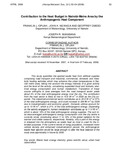| dc.description.abstract | This study quantifies the ejected waste heat from artificial supplies
comprising road transport and industrial, commercial, domestic and metabolic
heating activities which may enhance the urban temperatures in Nairobi
metro area, taking into account the energy intensity of a given activity
and the level of the activity, considering expended fossil and biofuels, electrical
energy consumption and human metabolism. Translation of linear
source strengths to area averages from the road transport sector yields
about 4% of the total anthropogenic energy over the city. The contribution
from the road sector is likely to rise to 10.8 W m-2 in 2029 as the City expands.
The industrial/commercial sector contributes up to 35.5 W m-2 or 57%
of the total anthropogenic energy, and could increase to 284 W m-2 by 2029
due to industrialization and economic growth. Domestic utilities account for
up to 13 W m-2, which is 21% of the total anthropogenic energy. Depending
on the activity engaged in, human metabolism contributes up to 11.4 W m-2,
which is about 18% of the total anthropogenic energy supplies. The sum total
area-averaged anthropogenic energy consumption over the city centre is
currently small, constituting about 11 to 18% of the global radiation for the
warmer and colder seasons, respectively. Notably, only a part of this energy
is released into the atmosphere as waste heat as most is used for the intended
purposes. If the current trends of rising population, increased motor
vehicle density and enhanced industrialization persist, the anthropogenic
waste heat ejection would be large enough to alter the heat balance of the
study area appreciably in future by 2030. | en |

